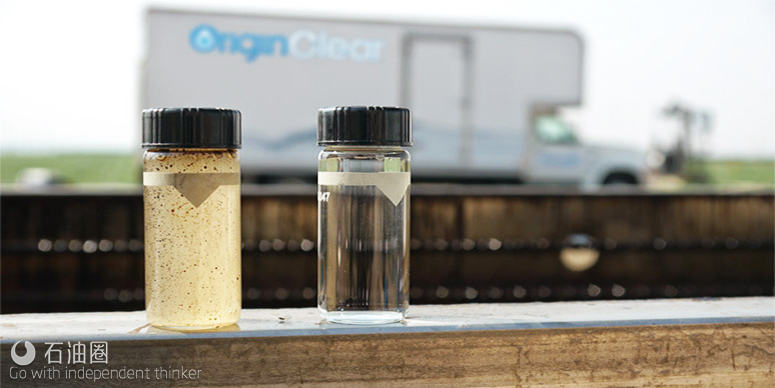The treatment and recycling of water in hydraulic fracturing operations remains critical to oil and gas operations.
A technology originally developed to harvest algae for biofuels production has proven effective in treating produced water from oil and gas wells in California’s Central Valley.
OriginClear, founded in 2007 as OriginOil, has expanded the applications of its technology to include produced water and wastewater treatment for refineries. Between 2010 and 2011, the company started testing its technology’s potential for treating flowback water from unconventional oil and gas operations. Since that time, the technology’s application has been expanded for produced water and wastewater treatment for refineries, JL Kindler, CEO of OriginClear technologies, told Rigzone in an interview.
The hydraulic fracturing process not only unlocked U.S. shale resources, but boosted the amount of water used by the oil and gas industry. Between 2000 and 2014, the estimated median annual water volume in hydraulic fracturing grew from around 177,000 gallons per oil and gas well to more than 4 million gallons per oil and 5.1 million gallons per gas well, the U.S. Geological Survey reported last year.
Looking to reduce their costs and maintain access to supply, oil and gas producers have been investing in water conservation and recycling efforts, the Wall Street Journal reported last year. These efforts continued even as oil and gas companies cut spending in other areas in response to low oil prices.
Bloomberg reported last year that oil and gas companies operating in California were looking to recycle the water they have pumped out of the ground. California’s ongoing drought and greater scrutiny of the state’s 50,000 disposal wells – into which regulators had mistakenly allowed companies to inject wastewater near underground drinking supplies – brought conservation efforts to the forefront of conversation in the state.
The shortage of and demand for water means farmers in California’s Central Valley are paying between $1,500 to $2,500 per acre for water to irrigate their fields, Kindler said. Meanwhile, California oil and gas companies produced over 2.5 billion barrels of water each year from all onshore and offshore production activities. While the state’s agricultural industry has not only struggled to operate as normal but keeping fields viable, oil and gas operators have faced an overabundance of produced water that must be handled and managed, according to an OriginClear report. A number of technologies are being tested and used for produced water treatment, including hydrocyclones, induced gas floatation, walnut shell filters, electrolysis technologies, membrane filtration, ion exchange and chemical softening systems.
OriginClear worked with a Bakersfield, California-based exploration and production firm to test OriginClear’s electrolysis technology in treating produced water for beneficial reuse in the operator’s cyclic steam boilers and for agricultural irrigation. In the tests, OriginClear’s electrolysis technology provided upfront de-oiling and bulk suspended solids removal; this was followed by a polymeric ultrafiltration membrane (UF) being used to remove any remaining oil and suspended solids to acceptable reuse levels.
The process was successfully quantified in field testing in Bakersfield in the early part of 2015, OriginClear noted in a report. The raw feed had an average turbidity of 842 nephelometric turbidity unit and the treatment scheme offered greater than 99.8 percent removal of turbidity. In addition, the oil levels being fed to the electrocoagulation unit were in the range of 50 to 150 mg/l, while the UF membrane consistently provided effluent with non-detectable levels of oil.
“The combination of solids and oil removal demonstrated to the oil producer that this treatment scheme provided effluent appropriate for their reuse purposes,” according to the report.
The basics of OriginClear’s technology remains the same as when Rigzone first reported on the company in 2012. However, an evolution has occurred in the sense that the electro oxidation stage has been added as a specific feature of the company’s process, Kindler said. This is where dissolved or miscible organics are addressed.
“Additionally, we came to the conclusion that electro-coagulation was not necessarily the optimal solution for solids removal, and we evolved towards an engineering strategy where we are more agnostic towards coagulation solutions that can be, in some cases, done via chemical mixing,” Kindler noted.
The value of OriginClear’s process is in the integration of floatation for solids and oil removal and oxidation for dissolved or miscible treatment functions, under minimal footprint and energy consumption, Kindler said.
On average, every barrel of oil produced in the United States generates eight barrels of produced water, Kindler said. This produced water has to be treated for bacteria before it can be used elsewhere. The cost of treating water ranges from $3 per barrel in Texas to as much as $20 per barrel in Pennsylvania.
The oil and gas industry is approaching the perfect storm as water becomes less available and regulations governing disposal wells increase, Kindler noted, adding that the company has come to realize that the oil and gas business is actually in the water business.
The oil and gas industry faces new regulations governing water in states such as Pennsylvania. Earlier this year, Pennsylvania’s Department of Environmental Protection finalized rules governing conventional and unconventional oil and gas. Under these new regulations, drillers would have to restore or replace tainted water supply to meet federal Safe Drinking Water Act standards, or the pre-drilling conditions, if they were more stringent.


 石油圈
石油圈
